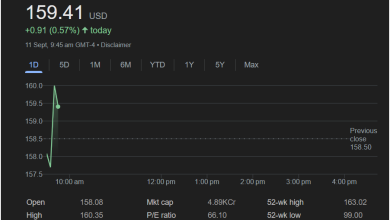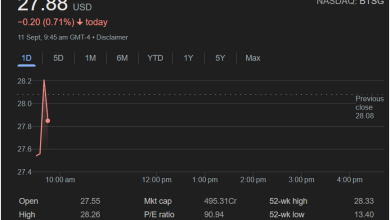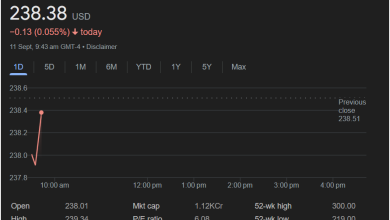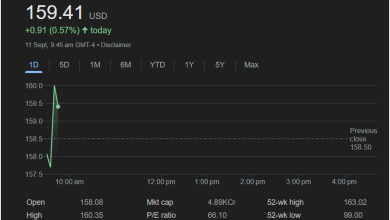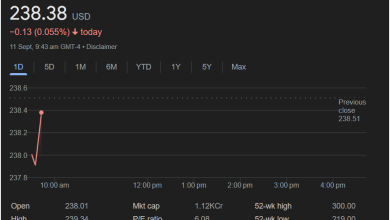JPMorgan Chase & Co. Stock Shows Resilience Amidst Market Fluctuations
A Closer Look at the Financial Giant's Performance and Future Outlook
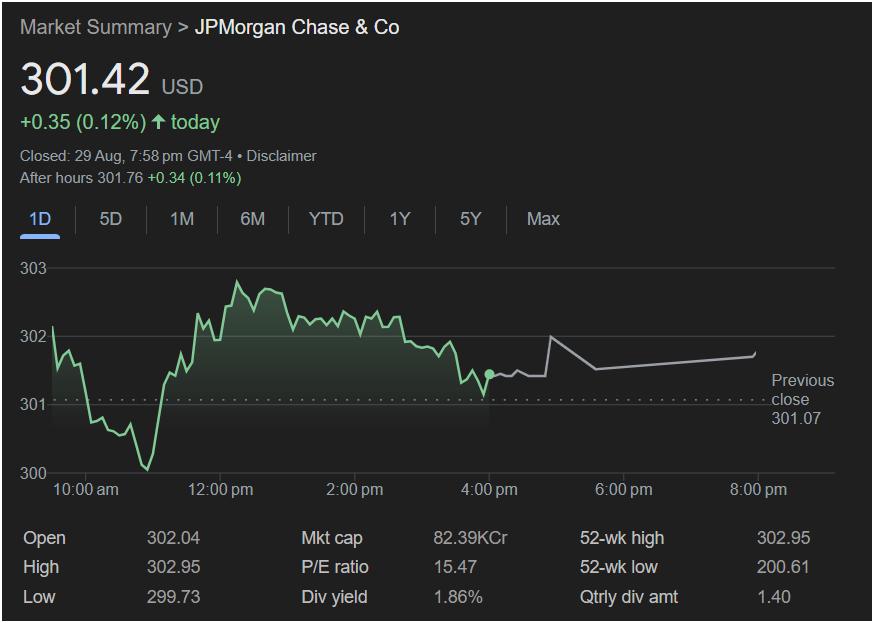
New York, NY – August 30, 2025 – JPMorgan Chase & Co. (JPM) concluded trading on August 29, 2025, with a closing price of $301.42, marking a modest gain of $0.35 (0.12%) for the day. While the increase may seem slight, it reflects a day of resilience for the financial behemoth, especially when considering the broader market’s typical volatility. The stock’s after-hours trading further solidified this positive sentiment, climbing to $301.76, an additional gain of 0.34%.
This performance comes amidst a dynamic economic landscape, where investors are keenly observing every move made by leading financial institutions. JPMorgan Chase, with its vast global presence and diversified business segments, often serves as a barometer for the health of the financial sector. Today’s movements, though not dramatic, paint a picture of stability and continued investor confidence.
A Day in the Life of JPM Stock: A Detailed Chart Analysis
Looking at the intraday chart, JPM opened at $302.04, indicating a strong start to the trading day. The stock reached a high of $302.95, showcasing moments of significant upward momentum. However, it also experienced a low of $299.73, illustrating the ebb and flow that characterizes daily market activity. This intraday fluctuation, while normal, provides insight into the various pressures and catalysts influencing investor behavior throughout the day.
The chart reveals a generally upward trend in the early hours, peaking around midday before experiencing some dips in the afternoon. Despite these pullbacks, the stock managed to recover and close higher than its previous close of $301.07. This ability to absorb selling pressure and still finish in positive territory is a testament to the underlying strength and investor belief in JPMorgan Chase’s long-term prospects.
Key Financial Metrics and What They Mean for Investors
Beyond the daily stock movements, several fundamental metrics provide a deeper understanding of JPMorgan Chase’s financial health and valuation.
-
Market Capitalization: At 82.39 Trillion Crore (82.39KCr), JPMorgan Chase stands as one of the largest financial institutions globally. This immense market capitalization reflects its extensive assets, revenue streams, and systemic importance within the financial system. For investors, a large market cap often signifies stability and a lower risk profile compared to smaller, more volatile companies.
-
P/E Ratio: The company’s Price-to-Earnings (P/E) ratio currently stands at 15.47. The P/E ratio is a widely used valuation metric that compares a company’s current share price to its per-share earnings. A P/E of 15.47 suggests that investors are willing to pay approximately 15.47 times its earnings for each share. This figure can be compared to industry averages and historical data to assess whether the stock is undervalued, overvalued, or fairly priced. In the current interest rate environment and given the banking sector’s performance, this P/E ratio appears to be within a reasonable range, indicating stable growth expectations.
-
Dividend Yield: JPMorgan Chase offers a dividend yield of 1.86%. For income-focused investors, dividends are a crucial component of their investment returns. A 1.86% yield, coupled with a quarterly dividend amount of $1.40, highlights the company’s commitment to returning value to its shareholders. Consistent dividends are often a hallmark of financially sound and mature companies that generate robust cash flows.
-
52-Week High and Low: The stock’s 52-week high is $302.95, which intriguingly was the intraday high reached today. This proximity to its annual peak suggests strong upward momentum and investor optimism. The 52-week low stands at $200.61, illustrating the significant growth the stock has experienced over the past year. This wide range between the high and low underscores the potential for both growth and volatility in the banking sector. The fact that the stock is currently trading near its 52-week high is a positive indicator for many investors, suggesting a strong trend.
JPMorgan Chase’s Strategic Position and Future Prospects
JPMorgan Chase’s performance is not just a reflection of daily trading but also a testament to its strategic positioning in the global economy. As a diversified financial services holding company, it operates in four major segments: Consumer & Community Banking, Corporate & Investment Bank, Commercial Banking, and Asset & Wealth Management. This diversification helps to mitigate risks and capitalize on various economic trends.
In the current environment, the banking sector faces both opportunities and challenges. Rising interest rates, while potentially boosting net interest income for banks, also bring concerns about economic slowdowns and credit quality. JPMorgan Chase, with its strong capital position and robust risk management frameworks, is generally well-equipped to navigate these complexities.
Recent economic indicators suggest a mixed outlook, with inflation remaining a key concern for central banks globally. However, strong employment figures and resilient consumer spending in many regions continue to provide a foundation for economic activity. As a major lender and financial intermediary, JPMorgan Chase is intrinsically linked to these macroeconomic trends.
The company has also been actively investing in technology and digital transformation, enhancing its customer experience and operational efficiency. These investments are crucial for staying competitive in an evolving financial landscape and attracting a new generation of clients. Furthermore, JPMorgan Chase’s commitment to sustainable finance and ESG (Environmental, Social, and Governance) initiatives is gaining increasing importance among investors, reflecting a broader shift in market priorities.
Analyst Perspectives and Investor Sentiment
Market analysts generally hold a positive to neutral outlook on JPMorgan Chase, citing its strong leadership, solid balance sheet, and consistent profitability. While some may point to potential headwinds such as increased regulatory scrutiny or economic uncertainties, the consensus often highlights the bank’s ability to generate strong earnings and maintain its market leadership.
Retail and institutional investors alike continue to view JPM as a core holding in well-diversified portfolios. Its status as a “too big to fail” institution, coupled with its consistent dividend payments and long history of navigating economic cycles, makes it an attractive option for those seeking stability and long-term growth.
Conclusion: A Steady Ship in Dynamic Waters
JPMorgan Chase & Co.’s performance on August 29, 2025, closing at $301.42 with a modest gain, underscores its resilience and stability in a constantly shifting market. The detailed analysis of its intraday movements, key financial metrics, and strategic positioning paints a picture of a financial giant that is well-prepared to navigate the challenges and seize the opportunities that lie ahead.
As the global economy continues to evolve, JPMorgan Chase remains a pivotal player, and its stock performance will continue to be a closely watched indicator for investors seeking insights into the broader financial landscape. While no investment is without risk, the current data suggests that JPMorgan Chase continues to be a steady ship in dynamic waters, offering a compelling proposition for those looking for a blend of growth, income, and stability in their investment portfolios.
Here’s an image depicting the strength and stability of JPMorgan Chase in the financial market:
